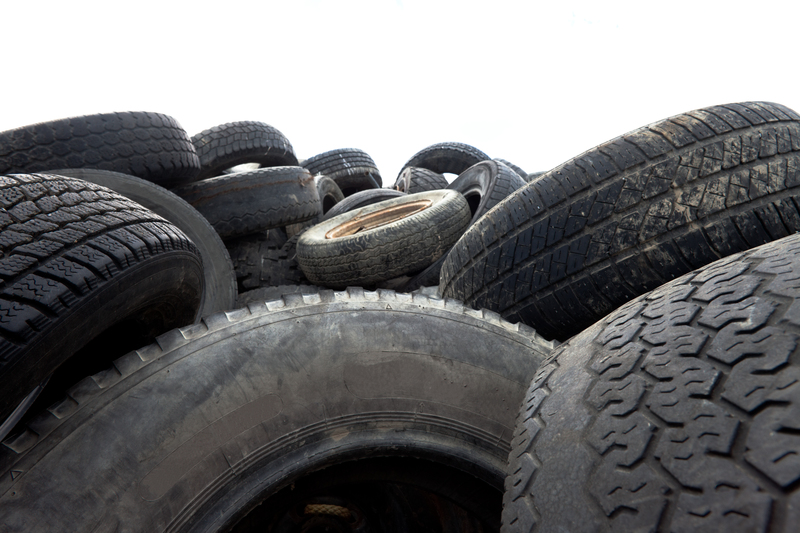Prioritize Safety: The Plastics to Avoid in Your Home
Posted on 26/10/2025
Prioritize Safety: The Plastics to Avoid in Your Home
When it comes to maintaining a healthy and secure home environment, understanding which plastics to avoid is a crucial step for every homeowner. While plastics offer convenience, affordability, and impressive durability, not all plastics are created equal: some compounds found in everyday plastics have raised significant health concerns. This comprehensive article will inform you about the plastics that present the most risks, why you should be cautious, and safe alternatives you can choose.
Why Does Plastic Safety Matter?
Plastics are an integral part of modern life, from food containers and water bottles to children's toys and cleaning products. However, the chemicals used to manufacture certain plastics can leach into the products they contain, potentially endangering your health and the well-being of your family. Scientific studies have increasingly shown connections between exposure to specific plastic compounds and a variety of health issues, such as hormone disruption, cancer, and developmental problems in children.

How to Identify Different Types of Plastics
Before learning which plastics to avoid, it helps to understand how to identify them. Most plastic items come labeled with a recycling code--a number inside a triangle of arrows (usually found on the bottom of containers).
The most common plastic resin identification codes are:
- 1 - PET or PETE (Polyethylene Terephthalate): Commonly used in drink bottles and food packaging.
- 2 - HDPE (High-Density Polyethylene): Found in milk jugs, detergent bottles, toys, and more.
- 3 - PVC (Polyvinyl Chloride): Present in plumbing pipes, clear food packaging, shrink wrap, and more.
- 4 - LDPE (Low-Density Polyethylene): Utilized for sandwich bags, plastic wraps, and squeezable bottles.
- 5 - PP (Polypropylene): Used for yogurt containers, straws, bottle caps, and food containers.
- 6 - PS (Polystyrene): Known as Styrofoam, used for disposable cups, egg cartons, meat trays, and take-out containers.
- 7 - Other (often Polycarbonate or BPA-based): Includes various other plastics, often found in baby bottles, water bottles, and food storage containers.
Plastics to Avoid in Your Home
To prioritize health and safety, it's vital to recognize which plastics carry the highest risk and limit their use. Here are some of the most concerning types:
1. Polyvinyl Chloride (PVC, Recycling Code #3)
- Toxic Additives: PVC requires additives such as phthalates (plasticizers) to make it flexible, and these chemicals can leach into food, air, and dust.
- Hazardous Manufacturing: The production of PVC releases dioxins, potent carcinogens harmful to human health and the environment.
- Common Products: Shower curtains, plumbing pipes, window frames, clear food packaging, children's toys, and cling wraps.
Why avoid? Phthalates found in PVC are linked to endocrine disruption, reproductive issues, asthma, and even developmental delays in children.
2. Polystyrene (PS, Recycling Code #6)
- Contains Styrene: Styrene can leach into food and drinks, especially when heated or in contact with fatty foods. It is considered a possible carcinogen by the International Agency for Research on Cancer (IARC).
- Common Products: Foam take-out boxes, disposable cups and plates, egg cartons, grocery meat trays.
Polystyrene is easily transferred to food and especially dangerous when used in hot food or drink situations. Additionally, it's non-biodegradable, creating long-lasting environmental pollution.
3. Polycarbonate and Plastics with Bisphenol A (BPA, part of #7 category)
- Hormone Disruption: BPA is a synthetic estrogen that can interfere with hormone levels, impacting fertility, brain function, and potentially increasing cancer risks.
- BPA in Everyday Items: Water bottles, baby bottles, food storage containers, and the lining of many food cans.
While many companies are moving toward "BPA-free" plastics, be aware that some alternatives (such as BPS or BPF) may have similar or unproven health risks.
4. Plastics with Phthalates (often found in #3 and #7)
- Health Effects: Phthalates are associated with hormone disruption, asthma, attention deficit disorders, and learning disabilities.
- Exposure Sources: Vinyl flooring, shower curtains, scented products, and food packaging materials.
Other Concerning Plastics: Beyond the Usual Suspects
While plastics with codes #3, #6, and #7 pose the greatest risks, it's also wise to be cautious with certain uses of plastics #1 (PET) and #5 (PP):
- PET (#1): Generally considered safe for one-time use, but repeated use or exposure to heat (such as leaving a bottle in the sun or reusing it for weeks) increases the chance of chemical leaching.
- PP (#5): While often labeled microwave- or dishwasher-safe, polypropylene can degrade over time, releasing microplastics and potential chemicals.
How to Lower the Risks: Essential Tips for a Safer Home
Making safer choices with plastics isn't just about avoiding specific recycling codes; it's a comprehensive approach to a healthy home. Here are actionable strategies you can use right away:
- Choose Glass, Stainless Steel, or Ceramic: Use these materials instead of plastic for food storage, drinking, and cooking whenever possible. They don't absorb odors or leach chemicals.
- Inspect and Replace Plastic Items: Frequently replace plastic items that show signs of wear, cloudiness, scratches, or cracking. These defects make chemical leaching more likely.
- Avoid Heating Plastic Containers: Never microwave plastic containers or wash them in hot dishwashers, even if labeled "microwave-safe." Heat increases the risk of chemicals leaching into food.
- Be Wary of Recycling Codes #3, #6, and #7: These numbers tend to indicate the presence of the most hazardous chemicals and should be minimized in home use.
- Use BPA-Free and Phthalate-Free Products: Look for products that specifically state they are free from these harmful chemicals. However, research replacements for potential risks as well.
- Limit Single-Use Plastics: Cut down on items like disposable utensils, plates, straws, and water bottles, which are often made from problematic plastics and pollute the environment.
- Store Food Carefully: Don't use plastic wrap or containers for acidic or fatty foods (such as tomato sauce, cheese, or salad dressings), as these can increase leaching.
- Keep Toys Safe: For babies and toddlers, choose wooden, cloth, or certified safe plastic toys free from PVC, phthalates, and BPA. Babies frequently put toys in their mouth, increasing exposure risk.
- Improve Indoor Air Quality: Phthalates and other chemicals can "off-gas" into the air from plastics. Ventilate your home frequently and use an air purifier if possible.
Labels and Marketing: Reading Between the Lines
As awareness about unsafe plastics grows, manufacturers have begun to label products with terms like "BPA-free" or "phthalate-free."
- Don't Assume Complete Safety: Even "BPA-free" plastics may use other bisphenol compounds.
- Research Replacements: Some substitute plastics haven't been studied as thoroughly as BPA or phthalates, so stay updated on new research.
- Look for Certifications: When possible, purchase plastic items that are certified by independent organizations for food safety and low toxicity.
Children and Plastics: Special Precautions for Young Families
Babies and young children are more vulnerable to the harmful effects of toxic plastic chemicals due to their developing bodies. Here are smart steps for families:
- Switch to Glass Bottles and Silicone Nipples: Avoid plastic baby bottles and teethers, and select glass or stainless steel options.
- Inspect Toys for Safety: Choose toys made from natural materials and certified nontoxic plastics.
- Limit Plastic Dishes and Cups: Opt for silicone, bamboo, stainless steel, or glass instead of plastic plates, sippy cups, or utensils.
- Check for Recalls: Stay informed about recalls related to children's products and plastics, as regulations change over time.
The Environmental Impact of Unsafe Plastics
It's important to note that plastic safety isn't just a health concern--it's an environmental one. The production, use, and disposal of plastics like PVC and polystyrene generate persistent pollutants, microplastics, and toxic byproducts that persist for decades. By choosing safer plastics or reducing overall plastic use, you help safeguard both your family's well-being and the planet.
Summary: Smart Choices for a Safer Home
To prioritize safety in your home, it's essential to:
- Limit or completely avoid PVC (#3), polystyrene (#6), polycarbonate/BPA plastics (#7), and phthalate-containing materials.
- Replace plastic food storage, cooking, and drinking items with safer alternatives like glass, stainless steel, or ceramic.
- Never heat food in plastic containers or use worn/damaged plastic products.
- Pay attention to labeling and remain aware of new research regarding chemicals used in plastics.
- Make extra efforts to protect children and pregnant individuals from potentially harmful plastic chemicals.
Prioritizing plastic safety is a continuous journey
By staying informed and making conscious product choices, you can minimize exposure to the most dangerous plastics in your home. Each change, no matter how small, contributes to a healthier household and a cleaner environment for all.

Frequently Asked Questions (FAQs) About Home Plastics Safety
- Are all plastics dangerous?
- No, not all plastics are created equal. Plastics like HDPE (#2) and PP (#5) are generally regarded as safer. However, always consider usage, condition, and temperature exposure.
- Is BPA-free plastic safe?
- BPA-free plastics are an improvement, but some replacements (like BPS and BPF) may still have health concerns. When in doubt, choose glass or stainless steel.
- Does boiling or microwaving plastics increase risks?
- Yes. High temperatures can break down plastics and trigger chemical leaching into food or drinks. Avoid using plastics with hot items.
Final Thoughts
Understanding which plastics to avoid in your home is a key step toward a safer, healthier lifestyle. By favoring non-plastic materials, being vigilant about labels, and keeping up with scientific research, you can protect yourself, your loved ones, and the world you live in. Remember, every smart decision counts.
For the latest news and guidance on plastic safety, consult reputable sources like the Environmental Working Group (EWG), U.S. Food and Drug Administration (FDA), and local health authorities. Stay informed--and prioritize safety when it comes to plastics in your home!

